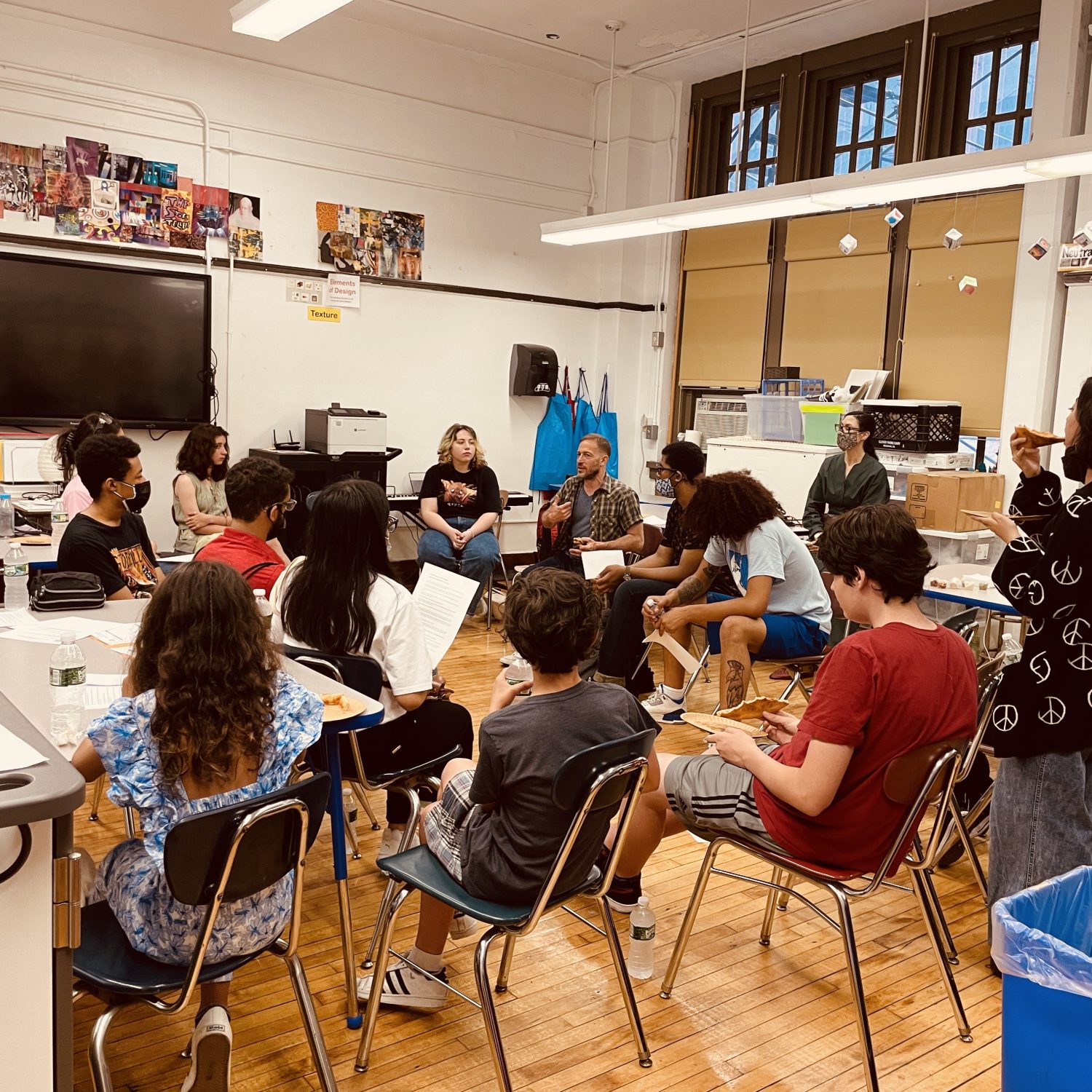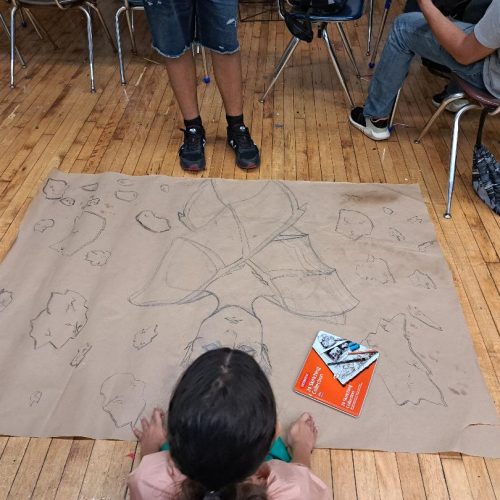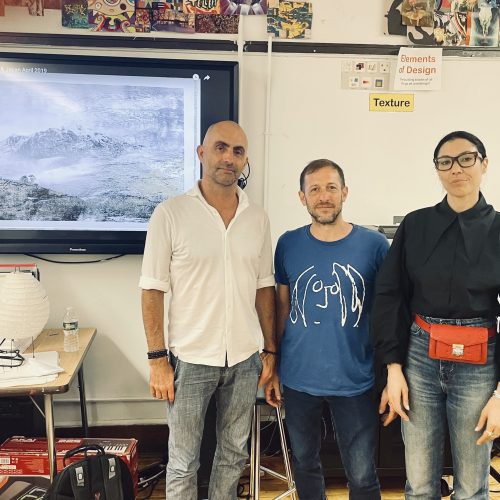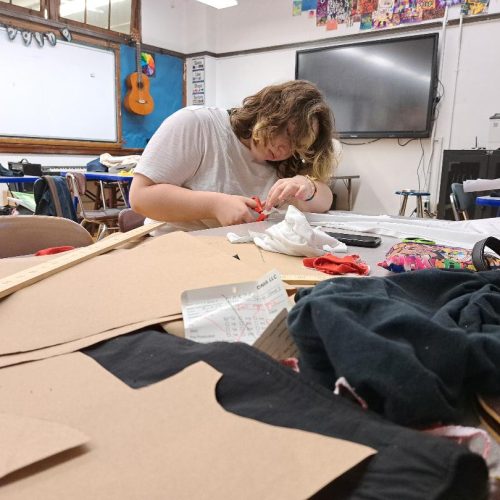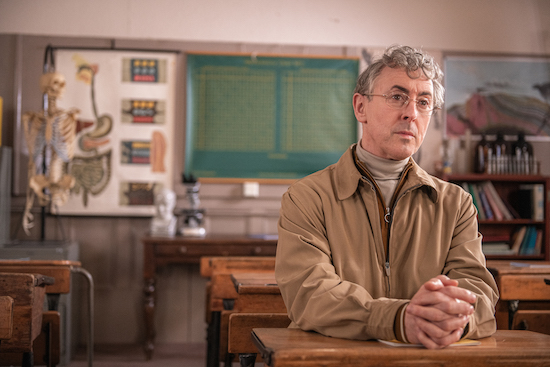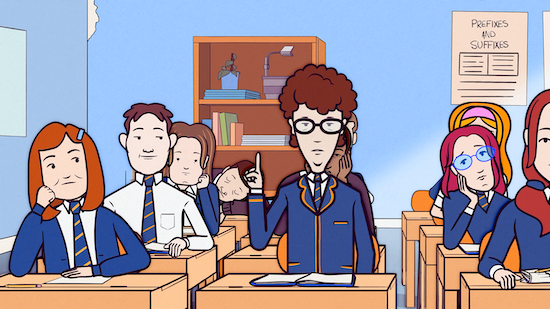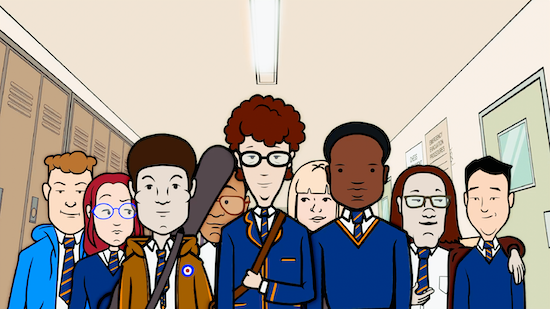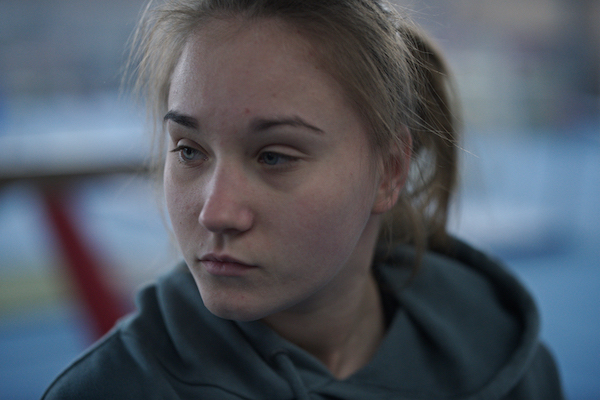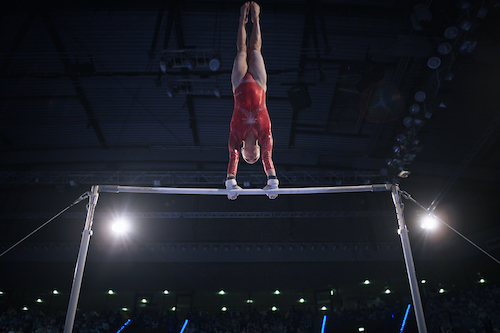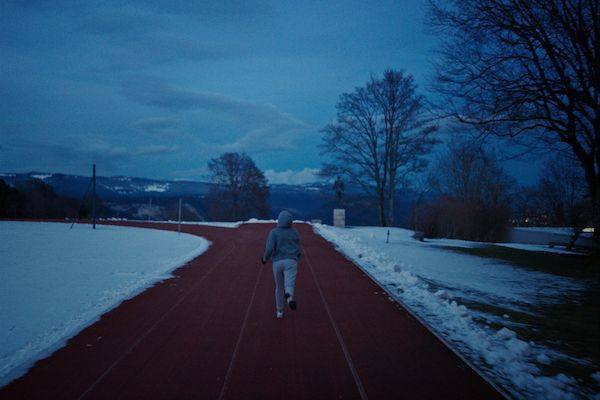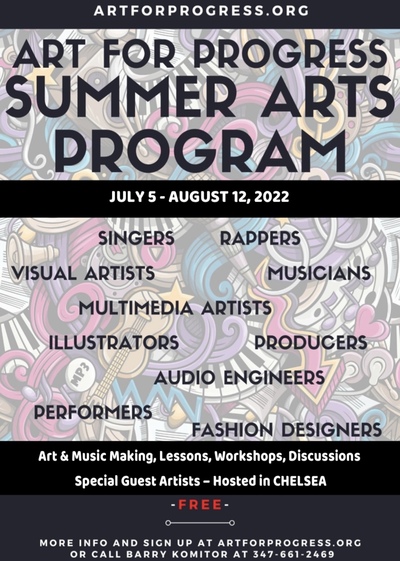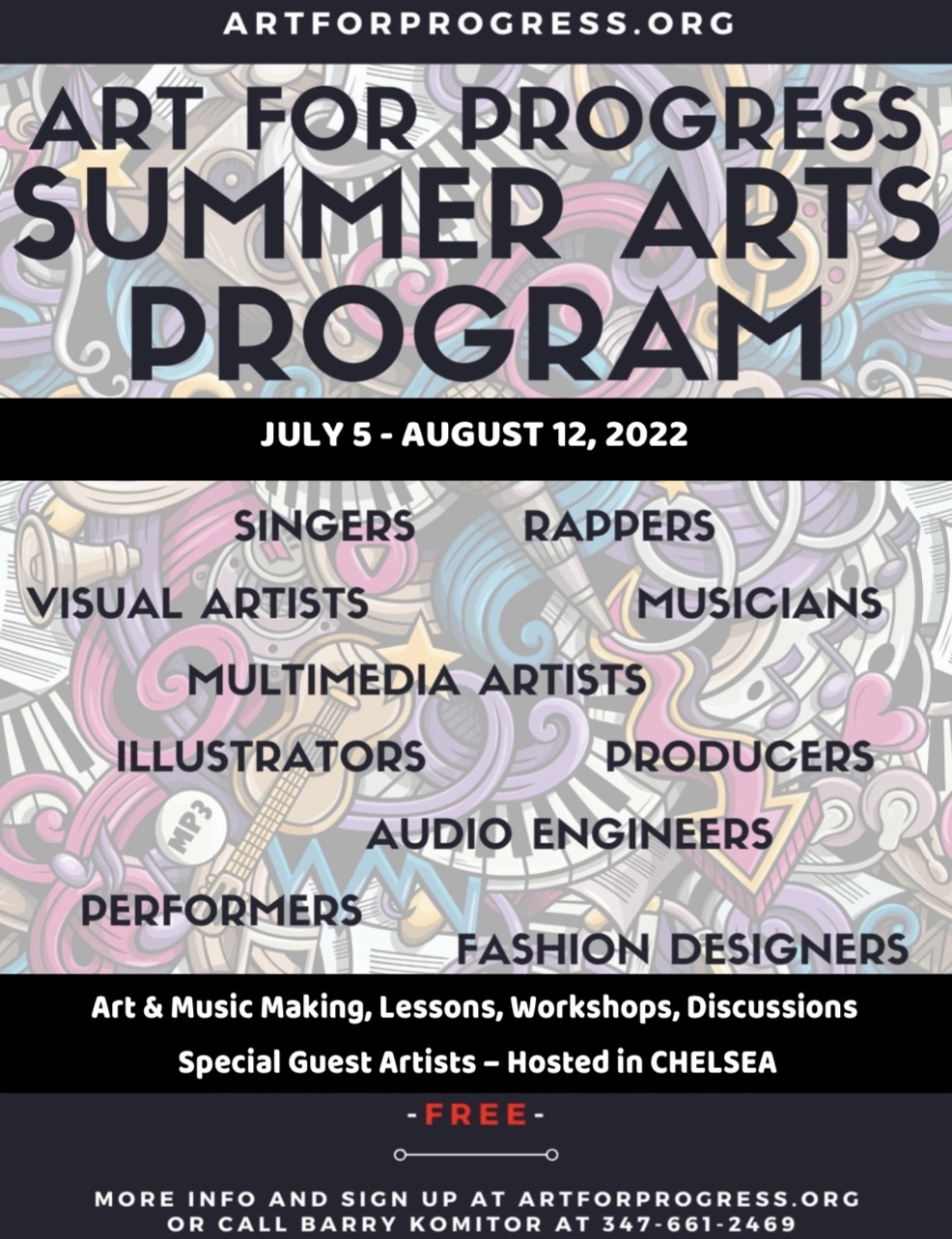- 3 years ago
-
Barry Komitor addressing students at orientation. It is a great moment to witness the progress we’ve made over the last two years. When the pandemic hit in 2020, Art for Progress (AFP) transitioned its summer program to a virtual platform, as did most folks, institutions, and non-profit organizations at the time. But this year, our in-person comeback is even more solid as we offer an amazing assortment of workshops ranging from pattern-making to music theory, and New York’s young art enthusiasts are soaking it all in.
Although we are running traditional-style workshops, the program is running slightly differently. AFP’s summer program starts every week off with open arts on Mondays. Open arts was devised as an interdisciplinary lab where every student is encouraged to float between workshops or work on specific skills requested by the student. The arrangement was conceived to assist students in taking on a more fluid approach in their practice and garner inspiration from one genre to the next. By providing them with an allowance of space and fluidity to experiment with mediums and engage in collaborative discussions with one another, all possibilities to spark the creative mind, commence exploration, and conceptualize innovative ideas begin. We want to motivate our children to play again. Playing is where genius is born.
Ayden and La Vie working on their collaborative preliminary sketch. During one of the music composition workshops led by Barry Komitor, and a fiber assemblage art workshop led by me, a question was brought up by one of the students. The question pertained to the relevance of art and music, and how mediums so “far” from one another could be integrated as a tangible art form. The following day AFP was joined by special guest artist and speaker Bill Claps, whose art installation ARTSpeak Incinerator Project has been exhibited at the Guggenheim. His works have also appeared in many prestigious galleries and art fairs, including the Salomon Arts Gallery, Aspen Fine Arts Gallery, Art Monaco, and Art Basel in Miami. Claps presented a retrospective of his work and shared a video portfolio that demonstrated the evolution of his practice, beginning with his abstract drawings evoking svelte silhouettes of the female form to his latest work that draws on textures, sound, textiles, and fashion. The latter was part of a collaborative effort with fashion designer Sophie Bonvin, whose purses are embellished in fine sheets of gilt shaped into circles and ovals, similar to the floating shapes found in Claps’ morse code work CODE, and the beautifully placed gilt on the surface of his photographs in his work Natural Abstractions.
Bill Claps (left), Barry Komitor (center), Beláxis Buil (right). Komitor circled back to the student’s prior inquiry on how an artist can integrate two varied mediums into one practice, observing that it does require discipline, practice, and an ability to bounce back from failure. Then, I seized the moment and gave the students another example to help them understand how a creative mind can capture inspiration from workshops and other artists as techniques and experiences are shared. I described a potential collaboration between Komitor’s music course and my fiber assemblage art course. This involved creating a fiber/textile installation with sound—one that could later become an interactive installation for the audience to engage with, developing the work on a much broader scale. I caught the Ah-ha gleam in their eyes once they understood how an artist must not only think creatively but also cohesively. By having Claps present his body of work, drawing on examples of cross-disciplined approaches and workshopping during the week (to experiment), the students are provided the proper dose of mentoring instead of having them go figure it out. This approach simply sets a student/person up for failure, which can discourage anyone from pursuing their passion. We want to break away from this approach and apply a rectified pedagogical method that closes gaps. It does not help anyone entering a competitive field, especially within the arts, to be abandoned. I believe our approach also supports how the community should look: a desire to see everyone succeed.
This is a special year for AFP. Thanks to The Pierre and Tana Matisse Foundation, AFP is able to expand its program and offer New York’s youth culture a knockout series of workshops. It offers what many art schools lack: innovation, play, business models and strategy, trade skills, support, and the cross-pollination of mediums and knowledge. Between Claps, Komitor, myself and all the scheduled guest artists appearing over the next three weeks, we plan to continue disseminating the wisdom, tools, and nurturing needed to cultivate, inspire, and embolden the brightest minds of our future.
Susanna cutting her pattern in class; fashion 101. By Belaxis Buil
Edited by Graeme (Global English Editing)
Latest News
- 3 years ago
-
Courtesy of Obscured Pictures It’s probably safe to say that Jono McLeod’s documentary My Old School isn’t quite like anything we’ve seen before, both in subject and format. This inventive and charmingly told tale about a renowned Scottish hoax is probably not familiar to most Americans, all the better for us to watch it unfold and deliver its surprises. Using current interviews, old footage and news reports, and many animated sequences, McLeod puts together a fascinating portrait of Brandon Lee (not the late actor), his former classmate at the posh Bearsden Academy in Glasgow. Though Lee agreed to be interviewed, he declined to appear on camera, resulting in one of the film’s most interesting elements: venerable Scots actor Alan Cumming “stars” as Lee, expertly lip-synching his story. (All of the other film’s characters appear as themselves, as animated versions of themselves, or both.)
The tale begins in 1993, when Lee enters fifth form at Bearsden Academy, located in one of Glasgow’s fancier neighborhoods. Tall and somewhat odd-looking, he stands out from his 16-year-old classmates in several ways, including his deep voice , unplaceable accent, and formal clothes.
Courtesy of Obscured Pictures His fellow classmates soon find out that Lee had previously lived in Canada with his late opera-singer mother, toured with her extensively, and had been privately tutored, which explained his accent and advanced age. His ”mask-like” appearance was due to plastic surgery after a tragic car accident that left his face disfigured. He now lived in a not-so–posh section of Bearsden with his grandmother.
We learn all of these details through cheerful interviews with several of Lee’s (and McLeod’s) former classmates (now in their 30s) and teachers, who recall their first impressions and subsequent relationships with Lee. Their memories are illustrated by colorful 1990s-style animated scenes that are stylistically reminiscent of that decade’s sitcom Daria.
Eventually, this strange newcomer—a wiz in biology and an expert in 70s and ’80s punk and new wave music—becomes less a figure of ridicule, achieving popularity with his relative sophistication and driving skills (apparently one can get a driver’s license earlier in Canada). He also befriends and changes the lives of two bullied kids, both of whom as adults reminisce about him affectionately. Lee is eventually cast in a school production of South Pacific, blowing everyone away with his singing and stage presence. All the while, there are tantalizing clues to his mysterious past, but his real story is so far out that no one picks up on it.
Courtesy of Obscured Pictures Things start to unravel, however, after a vacation with a couple of classmates, and we finally learn his real, incredible story. We also (finally) get to see his actual face in old footage and photos, a highlight that McLeod almost teasingly builds up to.
My Old School is a mostly light-hearted, entertaining film, its tone set by the amusing interview snippets with Lee’s former classmates and the use of droll animation. It’s true that no crime was actually committed nor was any real harm done by Lee’s hoax, though certain aspects of his behavior were certainly unseemly (and he himself clearly has some psychological issues). In someone else’s hands, this story could have been shown in a harsher light. As it is, My Old School should not cause viewers to lose any sleep about the ever-surprisingly weirdness of human beings. And that is not a bad thing.
My Old School opens theatrically on Friday, July 22, at Film Form in NYC.
—Marina Zogbi
- 3 years ago
-
Photo courtesy of Kino Lorber Olga, a timely film directed and co-written by Elie Grappe, uses the 2014 Euro-Maidan Revolution in Ukraine as the setting for a coming-of-age story about a teenage gymnast who is torn between countries and allegiances. Written in 2016 and completed in early 2021, the film predates the recent Russian invasion, effectively shedding light on events that led up to the current war. Mainly, though, it is a tension-filled portrait of the title gymnast (portrayed with sensitivity by Anastasia Budyashkina, former member of the Ukraine national reserve team), who at age 15 relocates from Kiiv to Switzerland to train for the European Championship with the Swiss national team.
The move is is not easy for Olga, whose late father was Swiss, but it is for her own safety. In an early scene, she and her mother, Ilona (Tanya Mikhina)—a journalist who is investigating the corrupt administration of then President Viktor Yanukovych—are targets of pro-government violence. Despite concern for her mother and ambivalence about leaving home, Olga moves to the pristine alpine countryside to live with her grandfather and other paternal relatives.
In order to compete with the Swiss team, Olga must become a citizen; since Ukraine doesn’t permit joint citizenship, she is forced to choose between the only home she’s known and the opportunity to pursue her Olympic dreams. This is another tough decision, complicated by the wide culture and language gap between Olga and her Swiss teammates, who cannot imagine what she is going through. Olga often connects via FaceTime with her best friend, Sasha (Sabrina Rubtsova, also from Ukraine’s reserve team), who enthuses about the escalating protests by Ukrainian citizens.
Photo courtesy of Kino Lorber Meanwhile, there’s the actual training. Grappe shows many scenes of tough workouts in real gymnastic facilities. (The trainers and some of the athletes are members of the Swiss national team.) Determined to master one particular move on the uneven bars, Olga trains hard and repeatedly, despite warnings from her coach. Her introverted, steely-eyed determination is palpable, earning her the nickname “robot.” Olga is clearly experiencing tremendous emotional turmoil as the revolution escalates. On her phone, she watches alternately rousing and terrifying scenes of protestors in Kiiv raising their voices in song and getting beaten by police, her serenely beautiful Swiss surroundings shown in stark contrast with the chaos of Maidan (Independence Square).
Though initially rebellious, getting into physical altercations with her Swiss teammates and disobeying her coach, Olga gradually becomes part of the team as her relentless training pays off. She finally befriends a teammate and they goof off like normal teens, a much-needed outlet for Olga’s emotions. Still, life is tough–in addition to everything else, she must defend her mother’s actions and the Ukrainian uprising in general to her Swiss relatives.
Photo courtesy of Kino Lorber Things come to a head the night before the European Championship, as Olga receives some grim news. The film doesn’t flinch, nor does Olga in competition, but it’s clear she has to make a major decision about her future.
Though sometimes a bit meandering, Grappe’s film is a sobering and powerful portrait of a life under unimaginable stress. It’s a reminder of the many dislocated Ukrainians (and other refugees of war) who grapple with guilt and worry for choosing survival over the dangers of home. We’ve seen similar stories about real-life dancers, athletes, and others who pay a steep price for the privilege of safely continuing their careers. Theirs is a terrible burden that no one should have to shoulder, let alone a very young person.
Olga opens on Friday, June 24, at the Quad in New York City.
—Marina Zogbi
- 3 years ago
-
We are a little sad that next week will be our last week of the program and of course, summer is also winding down. We are fortunate and thankful that we can provide this program for NYC public school students. It was great getting to know many of our students. They were eager for the opportunity to learn from professional artists and find out more about careers in the arts.
LOCATION: Bayard Rustin Education Complex, 351 West 18th Street, Room 341, New York, NY. CONTACT: Barry Komitor (347) 661- 2469
The program will offer some workshops that will be ongoing while others will be one-offs. Each week we’ll post the schedule for the various workshops that will take place on Tuesdays and Thursdays. Mondays will be open arts day where students can work on music, visual arts and fashion design in an open, fun learning environment. Collaborations are encouraged! Special guest artists and speakers will also join us on Mondays.
Our main teaching artists for 2022 are Barry Komitor (music) and Beláxis Buil (visual art, fashion). We are planning to have many guest artist teachers and speakers this year as well.
Week 6: August 8th – August 12th
Monday, August 8th – 12:00PM – 3:30PM – Open Arts
Open Arts happens each week and gives students the opportunity to choose what they want to work on. Our teachers and special guest teachers will offer guidance and assistance.
*This weeks special guest artist speaker is fashion designer Gabe Padilla! You don’t want to miss this!
Tuesday, August 9th – 12:30PM – 2:00PM
MUSIC: Putting It All Together – The Whole Artist
Embracing the life of an artist takes more than learning some skills and attitudes. Being an artist is about taking those skills and attitudes and manifesting them into something new in the world. There are many decisions to make about what you want to show people. What is the intention behind what you are doing? This will change and evolve as you grow, but this class will be about checking in with those intentions and aligning them with real world goals and actions.
VISUAL ART: Critique
For our last week in art the students take a deeper dive at critiquing one another works of art. After demonstrating how critiques work and what language is used to critique artworks in the professional art field the students will take turns evaluating their peers.
Tuesday, August 9th – 2:00PM – 3:30PM
MUSIC: Getting In the Mix – How to Become Part of the Music Community
By enrolling in this program, you have taken an important step toward being a part of the music community in NYC. In this class we’ll talk about the many different opportunities for musicians. We’ll start with how to find and choose collaborators, then discuss how to get your group and your music out into the world. We’ll talk about how to get gigs, but also about joining jam sessions, performing at community events and parties, and busking in public. Music festivals are also a great place to interact with other players and producers. We’ll also go over a variety of ways to share and proliferate your music online and through a constantly changing landscape of apps and new technologies.
VISUAL ART: Production
During AFP’s last week at camp the focus turns towards finalizing projects and what steps must be taken to ensure production goes well. In the instance of art, this workshop aims to help students organize an exhibition as a team, understanding how each person has an important role to play and how each one must carry responsibilities that need to be met in order to facilitate a successful project.
Thursday, August 11th – 12:30PM – 2:00PM
MUSIC: Basic Audio Mixing – How to Get Your Tracks to Sound Better
It’s so easy to layer a bunch of sounds together, that getting them all to sit right and sound like one cohesive piece of music can quickly get out of hand. Bass frequencies start flubbing out, and the master level gets more and more distorted unless we apply a few basic concepts. We’ll look at leveling, equalization, compression and reverb as tools to open up space in a mix and to make sure your tracks come across with the energy.
VISUAL ART: The Art of Assemblage (ongoing)
For decades artists such as Man Ray, Sarah Lucas, Jannis Kounellis, Karla Kantorovich, Beláxis Buil have practiced the art of assembling disparate elements. In this course the students are asked to recycle found objects, trash, and everyday objects to create a sculptural, well-textured assembled art piece. A variety of practices will be explored: sewing, collaging, painting.
Thursday, August 11th – 2:00PM – 3:30PM
MUSIC: The Dynamics of a Band (ongoing)
In this class we’ll explore the roles of the different instruments and personalities in a musical group. We’ll explore both the sonic and interpersonal dynamics that go into preparing for and playing a live show including: active listening, rehearsal etiquette, personal attitudes, leadership and supporting roles, and achieving optimum sound in any situation.
ART: Portfolio Review
In this workshop the students will be extended an opportunity to gather their completed works of art which will then be submitted as their portfolio. Their workshop is designed to prepare those students who are interested in attending specialized art schools.
- 3 years ago
-
Art for Progress Summer Arts Program Thanks to a generous grant from the Pierre and Tana Matisse Foundation, we are pleased to announce the summer arts program is funded for the next 3 years! We are looking forward to an exciting, enriching program for 2022.
We are very pleased to announce, the program will be in person in 2022 (unless NYC changes the current pandemic protocol)! The location is yet to be determined, but it will be a location that is accessible from all 5 NYC boroughs.
Also, the program will expand this year to offer workshops for younger students ages 10-13. Plus, the program which has been for a 4 week period in previous years, will now run 6 weeks. To coincide with NYC’s summer school program, the dates are July 5th – August 12th with afternoon sessions beginning at 1:00PM weekdays and some weekend dates as well.
Workshops will be offered in visual arts, music and other art disciplines with special guest teaching artists and weekly speakers.
You can sign up here: https://forms.gle/7cW1i8ak7dt7Qs8X8
Any questions, please email admin@artforprogress.org.
Stay tuned for many more details.

